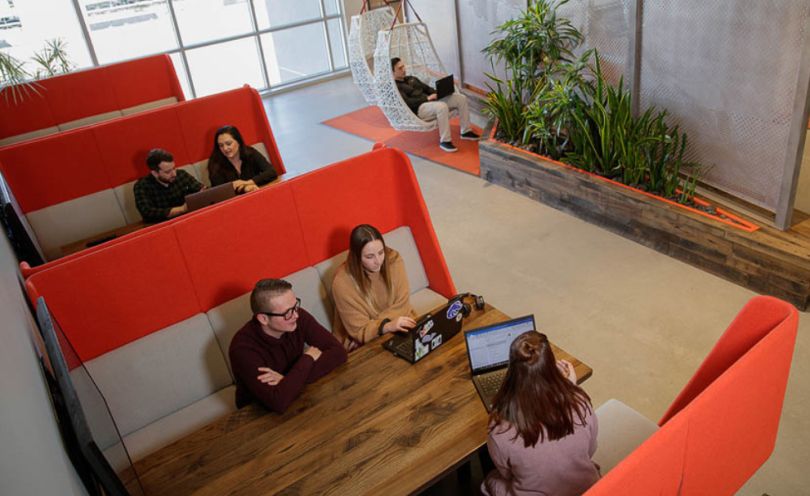According to Lysle Baker, a group product manager at Paylocity, there’s a familiar refrain that pops up in her team meetings.
“Where in the world is Lysle?”
This summer, it’s upstate Michigan, where Baker and her husband are living and working out of their RV during a three-month stint in the Great Lakes State — a comparatively sedentary stretch for the roving team member, who last summer toured National Parks in Utah, Montana and Wyoming.
Baker — who is technically based out of St. Louis and returns home when not traveling — said that the roving lifestyle wasn’t necessarily her plan when she joined the company. However, the idea was later green-lit when proposed to Paylocity, whose remote work model grants the flexibility to make Baker’s dream lifestyle a reality.
“My husband and I are always on the go,” Baker, who has been remote during her four-plus year tenure, said. “That’s been a key piece of our life. That's why remote work has been so important to me. The only thing between me and a travel lifestyle is good internet.”
Baker’s colleague, Chicago-based Head of Data Engineering & Reporting Rene Haase, has also benefited from Paylocity’s remote work model, having been able to log over a month in Germany with his children this summer while keeping U.S. working hours.
“I told my management team about it, and they were like, ‘Sure, go for it.’ There is a lot of flexibility and different ways of accommodating people to make it work, which has been super cool,” Haase said.
For the Schaumburg, Ill.-headquartered company, remote work isn’t a new concept. According to Chief Human Resources Officer Cheryl Johnson, prior to the Covid-19 pandemic, a significant chunk of the Paylocity team worked remotely. Johnson estimates that now about 80 percent of the 5,000-person organization is fully remote, but individuals can go into the office whenever they’d like. New hires typically go full-time remote after an in-office welcome period.
As a people leader at an HR tech company, which offers solutions for payroll, recruiting, onboarding and other workplace essentials, Johnson extolls the value of pairing technology that facilitates social interaction with a culture of connection to help employees feel invested in and part of the remote whole. For example, Johnson mentioned using Paylocity’s video capability within the product suite to share video messages from new hires — versus, say, email announcements — to amp up excitement around their addition to the org.
“It’s not even recreating the way you used to do things, just virtually. It’s actually coming up with new ways to create a personal emotional connection when you’re not in person,” Johnson said.
Chatting all things remote work with Built In Chicago, Johnson, Baker and Haase outlined the ins and outs of their employer’s remote work model and how it plays to their strengths.

What do you think has made remote work work well and made it successful?
Johnson: First and foremost, you have to have the right technology to support people working remotely. Because if you don’t, it just falls flat. Additionally, every other week, we have live Q&As with our workforce and post the recording to Community, Paylocity’s social collaboration hub, for those unable to attend the live session. We’re on camera and we answer questions and keep them informed. If you’re going to have this environment where people don’t see and feel the culture by being physically present, you’ve got to find other ways for people to see and feel the culture.
That also goes with having really good recognition programs to ensure that people still know what it takes to be successful. Recognition at Paylocity is built right into our own product by sending Impressions to one another based on our core values. When you’re in person, you can walk around and see it — who’s this and who’s getting ahead and stuff like that. But when you’re not in person, you’ve got to be able to show people in a very different way what it takes to be successful and connected.
Baker: We really try to accommodate people’s work-life balance and schedules and have certain parameters where we may not schedule meetings outside of different business hours, because we want to make sure we’re understanding of where people are in different time zones. Though many are remote, we also have the opportunity to do face-to-face gatherings.
Leveraging Their Own Solutions
How do you lead a team remotely?
Johnson: For me, it’s really important that I know the people on my team — not just their name, because it’s on an org chart or an email distribution list, but because I’ve actually seen them and know who they are. That’s a really important part of leadership, from my perspective. When we were in person, this was way easier. Now, you have to find a different way to know the people on your team. If you’re just a name or number, there’s no emotional investment or attachment to your colleagues.
That’s why I started doing a cross-functional monthly lunch meet and greet. We send Uber Eats, people order food and we hang out over lunch. It’s totally casual.
Baker: It’s important to understand what working style your teams have, how they’re going to be the most successful and try to accommodate. Everyone’s different. We have to make sure that we understand at a high level what those boundaries are for people and how we can help respect them.
Haase: If you don’t have one-on-ones scheduled, there’s a good chance you’re not going to have any one-on-one opportunities with your team members. Since I started working remotely, I’ve prioritized one-on-ones much more.
Notable Projects

Lysle and Rene, what about the Paylocity culture makes these opportunities to travel doable?
Haase: Management works with you to figure out what you need. It’s been a lot of fun and coming back to work, I feel really recharged. I’ve been able to have unique experiences and then feed off of those during work. I still checked in with my team; my direct reports knew I was going to Germany. People said communication was easy for them and they didn’t really notice much difference while I was away.
Baker: The whole culture has been very supportive, especially through Covid-19, about needing to be flexible. Work still has to get done. We all know what those commitments are and know what we need to do, but not everyone has to follow the same formula. People are different. We need to understand how we can flex to the different commitments and lifestyles that people have. Working with managers to make sure that everyone is aligned and on the same page and that there’s no business impact is critical. As long as you work within that kind of framework, remote work is successful.
Adjusting Hours
What remote work advice would you share with others?
Haase: Give people the truth and the flexibility to make things work for themselves, and you’ll find that people are quite excited about improving and have personal goals to achieve. At the same time, these people will invest in the company. By giving people freedom to experiment with remote work, you’ll often be positively surprised by what you find out.
Baker: One thing I’ve seen us do really well — especially in the last four years since I’ve started — is that we make a concerted effort to include everyone that needs to be included in meetings, regardless of whether they’re in person or not. We’ve improved that virtual feeling by investing in certain tools and technology.
Johnson: One of the most important things you can do as a leader is to make sure people know that you’re accessible because it is much harder to approach a leader when you’ve never personally met them and only see them on Zoom. Make sure that you take the time to let people know who you are as a person because that creates more of a connection.








